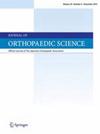Superior gluteal artery injury in pelvic ring injury and acetabular fracture: Single center observational study
IF 1.5
4区 医学
Q3 ORTHOPEDICS
引用次数: 0
Abstract
Background
Intrapelvic hemorrhage following pelvic fractures, including pelvic ring and acetabular fractures, originates from the venous system and the fracture. Arterial injury often causes significant bleeding and hemodynamic instability. The superior gluteal artery (SGA) is a frequently injured artery in patients with pelvic fractures. This study investigated the incidence and pattern of SGA injuries associated with pelvic fractures.
Methods
We retrospectively reviewed the medical records of patients with pelvic fractures who visited our institution between January 2016 and April 2022. Patients who underwent angiography for suspected arterial injury and SGA embolization were identified. Furthermore, the demographics and patterns of pelvic fractures were evaluated.
Results
In total, 2042 patients with pelvic fractures visited our trauma emergency department and 498 patients (24.4%) underwent embolization for arterial injuries. Of these, 30 patients (1.5% of the total and 6.0% of the patients who underwent procedures) received embolization therapy of the main trunk of the SGA. The mean age of patients was 51.2 (23–85 years), and the injury mechanisms were all high-energy injuries. There were 19 pelvic ring injuries, eight acetabular fractures, and three combined injuries. Acetabular fractures involved mostly both columns. The three combined injuries were lateral compression involving both columns, vertical shear involving both columns, and lateral compression with T-type fractures. Twelve (40.0%) occurred through the sciatic notch of different patterns.
Conclusions
SGA injury occurred in 1.5% of all pelvic fractures and was identified in 6% of patients receiving embolization. SGA injury occurs through various injury mechanisms and fracture patterns, even in the absence of a fracture in the sciatic notch. However, no conclusions could be drawn in this study on the association between SGA injuries, injury mechanisms, and fracture patterns. Since the prediction of SGA injury by fracture pattern is limited, angiography should be performed regardless of fracture pattern when an injury is suspected.
骨盆环损伤和髋臼骨折中的臀上动脉损伤:单中心观察研究。
背景:骨盆骨折后的骨盆内出血,包括骨盆环和髋臼骨折,源于静脉系统和骨折。动脉损伤通常会导致严重出血和血流动力学不稳定。臀上动脉(SGA)是骨盆骨折患者常见的损伤动脉。本研究调查了与骨盆骨折相关的SGA损伤的发生率和模式。方法:我们回顾性回顾了2016年1月至2022年4月期间到访我院的骨盆骨折患者的医疗记录。确定了因疑似动脉损伤而接受血管造影术和SGA栓塞的患者。此外,对骨盆骨折的人口统计学和模式进行了评估。结果:总共有2042名骨盆骨折患者到我们的创伤急诊科就诊,498名患者(24.4%)因动脉损伤接受了栓塞治疗。其中,30名患者(占总患者的1.5%和接受手术的患者的6.0%)接受了SGA主干的栓塞治疗。患者平均年龄51.2岁(23-85岁),损伤机制均为高能损伤。骨盆环损伤19例,髋臼骨折8例,合并损伤3例。髋臼骨折主要累及两列。三种复合损伤分别为双柱侧压伤、双柱垂直剪切伤和T型骨折侧压伤。12例(40.0%)发生于不同形态的坐骨神经切迹。结论:SGA损伤发生在所有骨盆骨折中的1.5%,在接受栓塞的患者中有6%被发现。SGA损伤通过各种损伤机制和骨折模式发生,即使在坐骨切口没有骨折的情况下也是如此。然而,在这项研究中,还没有得出SGA损伤、损伤机制和骨折模式之间的关系的结论。由于骨折模式对SGA损伤的预测是有限的,当怀疑损伤时,无论骨折模式如何,都应进行血管造影术。
本文章由计算机程序翻译,如有差异,请以英文原文为准。
求助全文
约1分钟内获得全文
求助全文
来源期刊

Journal of Orthopaedic Science
医学-整形外科
CiteScore
3.00
自引率
0.00%
发文量
290
审稿时长
90 days
期刊介绍:
The Journal of Orthopaedic Science is the official peer-reviewed journal of the Japanese Orthopaedic Association. The journal publishes the latest researches and topical debates in all fields of clinical and experimental orthopaedics, including musculoskeletal medicine, sports medicine, locomotive syndrome, trauma, paediatrics, oncology and biomaterials, as well as basic researches.
 求助内容:
求助内容: 应助结果提醒方式:
应助结果提醒方式:


